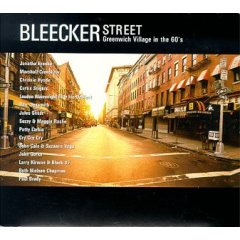When Erin and I traveled to Hawai’i last September, we spent several days at the home of my cousin Laura McHugh and her husband John, in Mililani, northwest of Honolulu. I didn’t write abut it at the time, but one of the coolest things about our stay was that John is a music fan who shares a lot of the same interests as me and my rock-critic friends. I found a stash of CDs I promptly had to put on my iPod, including a bunch of John Hiatt, and some gems I hadn’t even thought of in decades, like Green on Red, a late ’80s alt-rock group I had seen at the Mercury Cafe that I had once compared to Neil Young and Crazy Horse.
Anyway, it’s taken me months to pay John back, but I’ve burned him some of my favorite music. These CDs contain sounds that sustain me, surprises me and makes me smile when it comes up in my iPod, which is always set to shuffle through all my music.
 Various Artists
Various Artists
Bleecker Street: Greenwich Village In The 60’s
To a fan of folk and folk-rock music like me, this is a rare, and little-known, treasure. It came out a few years ago and I came across it at a Borders bookstore. It’s a compilation of ‘60s urban folk-era remade by contemporary singer-songwriters, and though some of the covers are reverential and dry, some are really fresh takes on these songs, all of which I’ve known for decades. My favorites include Jonatha Brookes’ crystalline, haunting take of Paul Simon’s haunting “Bleecker Street,†the tribute to the first folk era’s ground zero in Greenwich Village, from Simon and Garfunkel’s debut album. Another favorite is Loudon Wainwright III and Iris DeMent’s rollicking “Pack Up Your Sorrows,†which led me back to Richard and Mimi Farina’s greatest hits album, where the original still glows, and Cry Cry Cry’s beautiful version of Tom Paxton’s deeply moving “Last Thing on My Mind.†Droll baritone folkie John Gorka tackles Eric Andersen’s “Thirsty Boots,†John Cale and Suzanne Vega (!) wrap themselves around Leonard Cohen’s â€So Log Marianne†and Larry Kirwan of the NYC Irish rockers Black 47 revs up Phil Och’s still-relevant anti-war rant, “I Ain’t Marchin’ Anymore.†Yeah, I like everything on the disc, and I’ve turned many souls onto this disc. Continue reading










